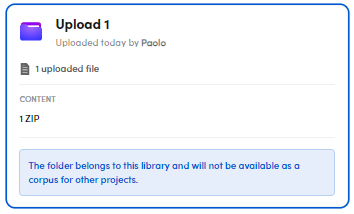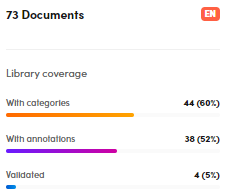Manage libraries
Change the library
To change your library:
-
Select Select project library.

-
Select the library of your interest.
The libraries dashboard
Manage the libraries of the categorization project using the appropriate dashboard.
To access the dashboard:
-
Open the Select project library drop-down menu on the main toolbar.

-
Select Manage libraries.
The dashboard shows:
- The project libraries list in the Libraries panel.
- Various data about the library in focus in the Edit Library panel.
Change the library in focus
To change the library in focus, select the library in the Libraries panel list.
Add a new library in the project
To add a new library:
- Select Add library
 in the Libraries panel.
in the Libraries panel. - Enter the library name under Library name and select Create.
-
In Corpora and folders, select the source for the library. You can select an existing corpus or upload documents from the file system.
If you choose to upload documents:-
Select Upload.
-
Select Show advanced settings:
- If you want to disable automatic language detection: turn off Autodetect language and choose the language from the Select language drop-down list.
- If you want to disable automatic character encoding detection: turn off Autodetect encoding and choose the encoding from the Select encoding drop-down list.
- If you later want to save the uploaded documents as a new corpus: select Save as corpus and enter a name for it.
- When done, select Hide advanced settings.
-
-
Select Add files.
- Select the files to upload.
The selected files are displayed in a list and can be deleted by clicking on the "X" button at the right of the file name. -
Select Upload.
When the upload is complete, a temporary uploaded corpus is created and made available in the window.Supported formats and limits
Supported document formats are those managed by the Apache Tika toolkit. Documents are automatically converted to plain text files during upload.
Documents are ignored if:
- They are empty.
- They mainly consist of nonsense words.
- (In case of automatic language recognition) Their language is unrecognized or not supported.
-
They exceed the following values:
- 50MB for
.zipfiles. - 50MB for
.txtfiles. - 50MB for other file types.
- 50MB for
-
Note
If you want to use a corpus, you can use these tools to find it:
- Use the search bar to look for a corpus. Your search must contain at least three characters.
- Select Show table view
 to view your corpora in a table format.
to view your corpora in a table format. - Select Show card view
 to view your corpora in a card format.
to view your corpora in a card format. - When in card view, you can sort items by selecting one of the options from the drop-down menu.
- When in table view, you can sort items by selecting the desired column header.
The information displayed in the existing corpora is the same displayed in the Corpus info sub-panel of the main dashboard.
Warning
A library imported into a new project that was previously exported from another project will only be available as a folder for this new one.

Import an annotated library
It is possible to upload annotated libraries on Platform. To upload a new library, see the dedicated section above.
Before uploading the library, an annotated library on your computer has two sub-folders inside it, each one with a specific function:
- test
- ann
The test sub-folder contains all the text files belonging to the annotated library, while the ann sub-folder contains all the files of the previous sub-folder, but with a different extension, .ann.
The main difference is the following: if you open a file located in the ann sub-folder, you will see all the categories that have been annotated in the corresponding text file located in the test sub-folder. You will find the annotations when looking at the documents either in the list view or in the detail view after the upload.
Example
This is a typical example of what you can find in an .ann file:
C1 C00001
C2 C00002
The letter C plus the number—for example 1—stand for the first category that you will see in the text in the Documents tab, while the multiple digit number stands for the category ID defined in your taxonomy.
Check the library source
Watch the Document sources area.
Add a library as favorite
To add a library as favorite, select Mark as favorite library.

Add documents
To add documents to the library:
- Select the library in the Libraries panel.
-
In the Edit Library panel, select Upload documents
 .
.-
Select Show advanced settings:
- If you want to disable automatic language detection: turn off Autodetect language and choose the language from the Select language drop-down list.
- If you want to disable automatic character encoding detection: turn off Autodetect encoding and choose the encoding from the Select encoding drop-down list.
- When done, select Hide advanced settings.
-
-
Select Add files.
- Select the files to upload.
The selected files are displayed in a list and can be deleted by clicking on the "X" button at the right of the file name. - Select Upload.
When the upload is complete, a temporary uploaded corpus is created and immediately merged with the current library. After a while the library will be automatically refreshed and the new documents will be available.
Export a library
To export a library:
- In the Edit Library panel, select Export library
 .
. - In the Export documents window, Export tab, enter the filename or confirm the suggested one and select the format in Extension.
- Documents are pre-processed when uploaded and spacing is affected. For example, a sequence of empty lines is compressed to one. If you want to export documents with their original spacing, check Include original text spaced documents.
-
Select the Export filter, to filter the document set to export:
- Confirm All documents to download the whole corpus. (Set by default).
Or:
-
Select Filtered documents to download a filtered list of the documents according to the following available filters:
- Documents with annotations
- Documents with categories
- Select Export.
- In the Download tab or in the notification in the lower right corner, select Download.
Edit library name
To edit the library name, select Edit library name  in the Edit Library panel.
in the Edit Library panel.
Delete a library
To delete a library, Select Delete library  in the Edit Library panel.
in the Edit Library panel.
Information about documents count, languages and coverage
For information about the number of documents, their languages and the coverage, watch the right part of the Edit Library panel.

Library usage
To check the library usage in the experiments, watch the Experiments strip.
Double-click the experiment to view it in the Experiments tab.
To check the generated model with the library, watch Generated models strip.
Select Quick start an experiment  to start an experiment based on the generated model.
to start an experiment based on the generated model.